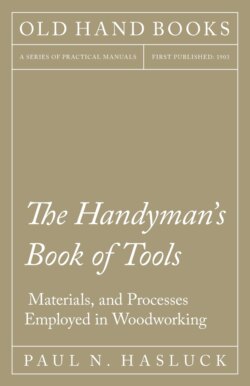Читать книгу The Handyman's Book of Tools, Materials, and Processes Employed in Woodworking - Paul N. Hasluck - Страница 128
На сайте Литреса книга снята с продажи.
THE BORING BRACE.
ОглавлениеThe brace supplies the most useful boring tool; from the variety of bits that can be used with it, it serves many purposes. It is better to buy the bits fitted to the brace, as they are more truly centred than those bought separate are likely to be, and the centreing of the bits is essential to their proper action. To try for centreing the bit, fix the brace in a vice by the head or cap; then rotate the brace, and observe if the bit turns concentric. The brace and bits are used for boring holes for nails, screws, or pins, for cutting circular holes, such as the circles for coins in cabinets, or for bottles in chemical cabinets, or for test-tube stands, and for making circles to serve as ornamentation. Wood may also be cut away in roughing out carving, frequently more quickly and certainly by the aid of a brace and bits than by any other means. Mortises are often better cut by first boring away the bulk of the wood; such a proceeding prevents splitting. The brace can be used to bore vertically or horizontally. The greatest force is obtained in the latter position, holding the cap with the left hand, and pressing with the stomach leaning against the tool. It is quite possible to break a brace by pressing on it too strongly. An iron one may bend, and if bent the bit is made eccentric. To bore vertically, the work should be low, so that the operator may lean over the top of the brace, and, holding the cap in the palm of one hand, press on the back of the hand with the right shoulder and turn with the other hand. Braces suitable for the woodworker’s use are illustrated by Figs. 371 to 374. Fig. 371 shows the simplest type of wooden brace, a thoroughly well-made though somewhat expensive tool, but it must be remembered that its life is very long. The body of the brace is of beech, but the head, where there is constant friction and wear, is of lignum vitae. Steel braces, much cheaper than wooden ones, are very largely used, and Fig. 372 is a type of them. The handle and head are of hard wood, and the body and jaws are of steel, the handle being strengthened with brass rings at the ends and the head turning on ball-bearings, as shown in Fig. 373. The form of the jaws is made quite clear; they are opened and closed by screwing the milled cnuck off or on respectively. Practically the same tool is shown by Fig. 373, with the addition, however, of a ratchet; by means of this it is not necessary to complete the revolutions of the sweep in awkward places where there is but little room in which to work. Having turned the sweep as far as it will go in the same direction as clock hands move, it can be brought back without the bit being twisted out of the work. The simple steel brace illustrated by Fig. 374 has a tapered square hole for the reception of the bit, the thumbscrew serving to tighten the split end when the bit has been inserted.
Fig. 370.—Using Gimlet.
Fig. 371.—Wooden Brace.
Fig. 372.—Steel Brace.
Fig. 373.—Ratchet Brace.
